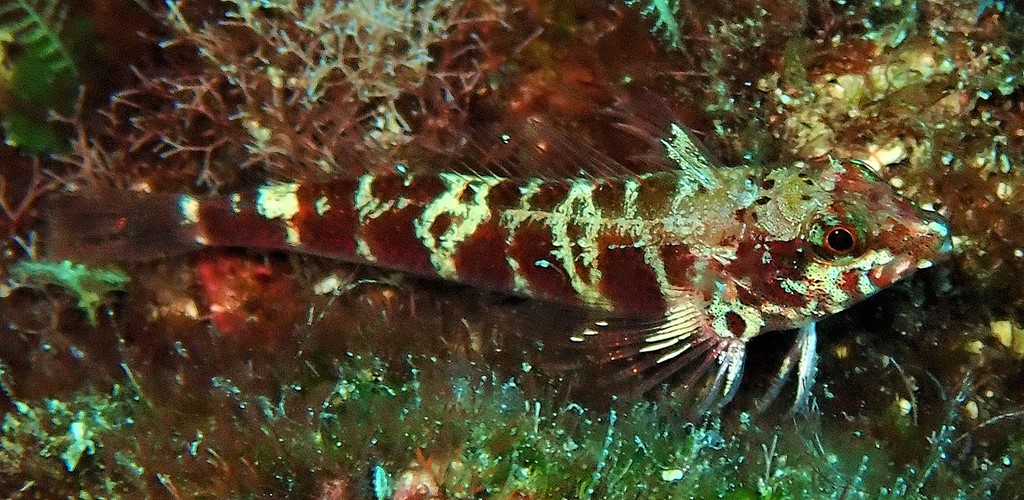ENNEAPTERYGIUS RHABDOTUS - (FRICKE, 1994)
Picture courtesy of: Alain Daoulas
Actinopterygii (Gigaclass) > Actinopteri (Class) > Teleostei (Subclass) > Blenniiformes (Order) > Blennioidei (Suborder) > Tripterygiidae (Family) > Tripterygiinae (Subfamily) > Enneapterygius (Genus)
South Pacific striped triplefin, Umpire triplefin, Kurenaihebiginpo, クレナイヘビギンポ, 棒状双线鳚,
Description
First dorsal spines (total): 3; Second dorsal spines (total): 11-14 (usually: 12); Dorsal soft rays (total): 7-10 (usually: 10); Anal spines: 1; Anal soft rays: 15-20 (usually: 16-18). First dorsal fin low in both sexes; Head, chest, and pectoral-fin base scaleless; Long and slender orbital tentacle; Tubular pored scales: 15-20, in the anterior lateral line series. Symphyseal Mandibular pores: 3.4 (formula: 3-4 + 3-4 + 3-4 = total pores: 9-12). Caudal fin Maximum size: 3.2 cm TL. Max. length: 2.7 cm SL. Depth range: 1 - 8 m.
Color
Male blackish on fins and anterior three-fourths of body and yellow caudal-fin with median black band. Sides of body light in males, with large triangular dark blotches reaching from the anal-fin base towards the dorsal-fin bases
Female yellowish with 3 broad, greyish double bars divided by thin grey line, broad black bar at base of caudal-fin, and greyish head with brown markings.
Etymology
Enneapterygius: from Greek, ennea = numeral nine + from Greek, pterygion = little fin. Referring to nine fins (3 dorsal, 2 pectoral, 2 ventral or pelvic, 1 anal, 1 caudal).
rhabdotus: from Greek, rhabdotos = striped. Referring to the 4 broad oblique band across the sides of the body.
Original description: Enneapterygius tutuilae Jordan & Seale, 1906 - Type locality: Anano Bay, Nuku Hiva, 8°56'S, 140°00'W, Marquesas Islands.
Distribution
Western Pacific: eastern Malaya (Malaysia) and Gulf of Thailand east to Society Islands and Marquesas Islands, north to southern Japan; South to Papua New Guinea, New Caledonia and Vanuatu.
Biology
Adults are found in coral and rocky reefs. Eggs are hemispherical and covered with numerous sticky threads that anchor them in the algae on the nesting sites. Larvae are planktonic which occur primarily in shallow, nearshore waters. Feeds on small benthic invertebrates.
Last update: 14, June 2022
Actinopterygii (Gigaclass) > Actinopteri (Class) > Teleostei (Subclass) > Blenniiformes (Order) > Blennioidei (Suborder) > Tripterygiidae (Family) > Tripterygiinae (Subfamily) > Enneapterygius (Genus)
South Pacific striped triplefin, Umpire triplefin, Kurenaihebiginpo, クレナイヘビギンポ, 棒状双线鳚,
Description
First dorsal spines (total): 3; Second dorsal spines (total): 11-14 (usually: 12); Dorsal soft rays (total): 7-10 (usually: 10); Anal spines: 1; Anal soft rays: 15-20 (usually: 16-18). First dorsal fin low in both sexes; Head, chest, and pectoral-fin base scaleless; Long and slender orbital tentacle; Tubular pored scales: 15-20, in the anterior lateral line series. Symphyseal Mandibular pores: 3.4 (formula: 3-4 + 3-4 + 3-4 = total pores: 9-12). Caudal fin Maximum size: 3.2 cm TL. Max. length: 2.7 cm SL. Depth range: 1 - 8 m.
Color
Male blackish on fins and anterior three-fourths of body and yellow caudal-fin with median black band. Sides of body light in males, with large triangular dark blotches reaching from the anal-fin base towards the dorsal-fin bases
Female yellowish with 3 broad, greyish double bars divided by thin grey line, broad black bar at base of caudal-fin, and greyish head with brown markings.
Etymology
Enneapterygius: from Greek, ennea = numeral nine + from Greek, pterygion = little fin. Referring to nine fins (3 dorsal, 2 pectoral, 2 ventral or pelvic, 1 anal, 1 caudal).
rhabdotus: from Greek, rhabdotos = striped. Referring to the 4 broad oblique band across the sides of the body.
Original description: Enneapterygius tutuilae Jordan & Seale, 1906 - Type locality: Anano Bay, Nuku Hiva, 8°56'S, 140°00'W, Marquesas Islands.
Distribution
Western Pacific: eastern Malaya (Malaysia) and Gulf of Thailand east to Society Islands and Marquesas Islands, north to southern Japan; South to Papua New Guinea, New Caledonia and Vanuatu.
Biology
Adults are found in coral and rocky reefs. Eggs are hemispherical and covered with numerous sticky threads that anchor them in the algae on the nesting sites. Larvae are planktonic which occur primarily in shallow, nearshore waters. Feeds on small benthic invertebrates.
Similar species
Enneapterygius shaoi (Chiang & Chen, 2008) - Reported from Western North Pacific: southern Taiwan. It can be distinguishde from Enneapterygius rhabdotus by its coloration; Body with pink or light orange color background with deep bron streaks (vs. brown background with black streaks) and dorsal fin membrane translucent with fin rays reddish in both sexes (vs. dorsal fin entirely black in male).
